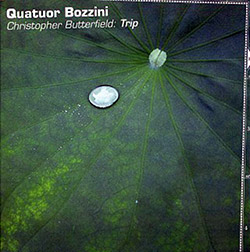
Butterfield (b. 1952) is a long-time teacher and composer, operating largely in Toronto and Montreal. As a teacher, he has a number of students working in various contemporary areas, including Wandelweiser-influenced, who assign him a great deal of credit for their development.
The Quatuor Bozzini, which also works out of Montreal, presents five of his works ranging in origin from 1991 to 2013: two quartets, a sextet and two solo pieces, all of them bracing and enjoyable. "Lullaby" (1991) adds an additional viola and cello. It's a somewhat disorienting lullaby, broken up at times by nightmarish shrieks, but by and large it wafts along with luscious, quavering harmonics, sometimes entering surprising, perhaps dreamlike song formations, reminding this listener of Ben Johnston's work. Maybe some Tenney as well. Generally, Butterfield's music, as represented here, often goes off in unexpected, delightful directions where one can hear (or think to hear) this or that reference but still comes away with more of a Butterfield-ness than anything else. "Lullaby" is an excellent example of this. "beach whistle" (1993) and "Clinamen" (1999) are solo works for cello and violin, respectively, the former a sober conversation of sorts between high and low, plucked and bowed, the later portions strangely melancholy and evocative while "Clinamen" is something of a dance, flitting from one light form to another (it's constructed from 80 short phrases which the violinist can combine in any sequence he/she chooses).
The final two pieces are for string quartet proper. As per the composer's notes, "fall" (2013) is "(b)ased on the chromatic rotation of a four-note row" with a randomized dynamic range. The result is a hymn like structure but, as Butterfield says, "unpredictable 'voice leading' and a sense of undependable harmony." One experiences a vivid spatial effect, the louder chards seemingly "nearer" than others, an otherwise self-similar landscape where perceived distance is the sonic qualifier. Additionally, the overall meditative aspect of the music itself permeates this landscape, somber and disquietingly beautiful. "Trip" (2008) is in four sections, the first three short (each less than 2:30) while the final lasts some 13 1/2 minutes. The three brief movements are brisk and rich (the first incorporating a talk radio capture), rather Neo-Romantic in flavor while the final (marked Adagio molto) is dark, scratchy, agitated and brooding, though not discarding an underlying tonality; I found myself thinking of Arnold Böcklin's paintings.
Overall an extremely satisfying release — absorbing music incisively performed by Quatuor Bozzini.
Comments and Feedback:



More Recent Reviews, Articles, and Interviews @ The Squid's Ear...


|

